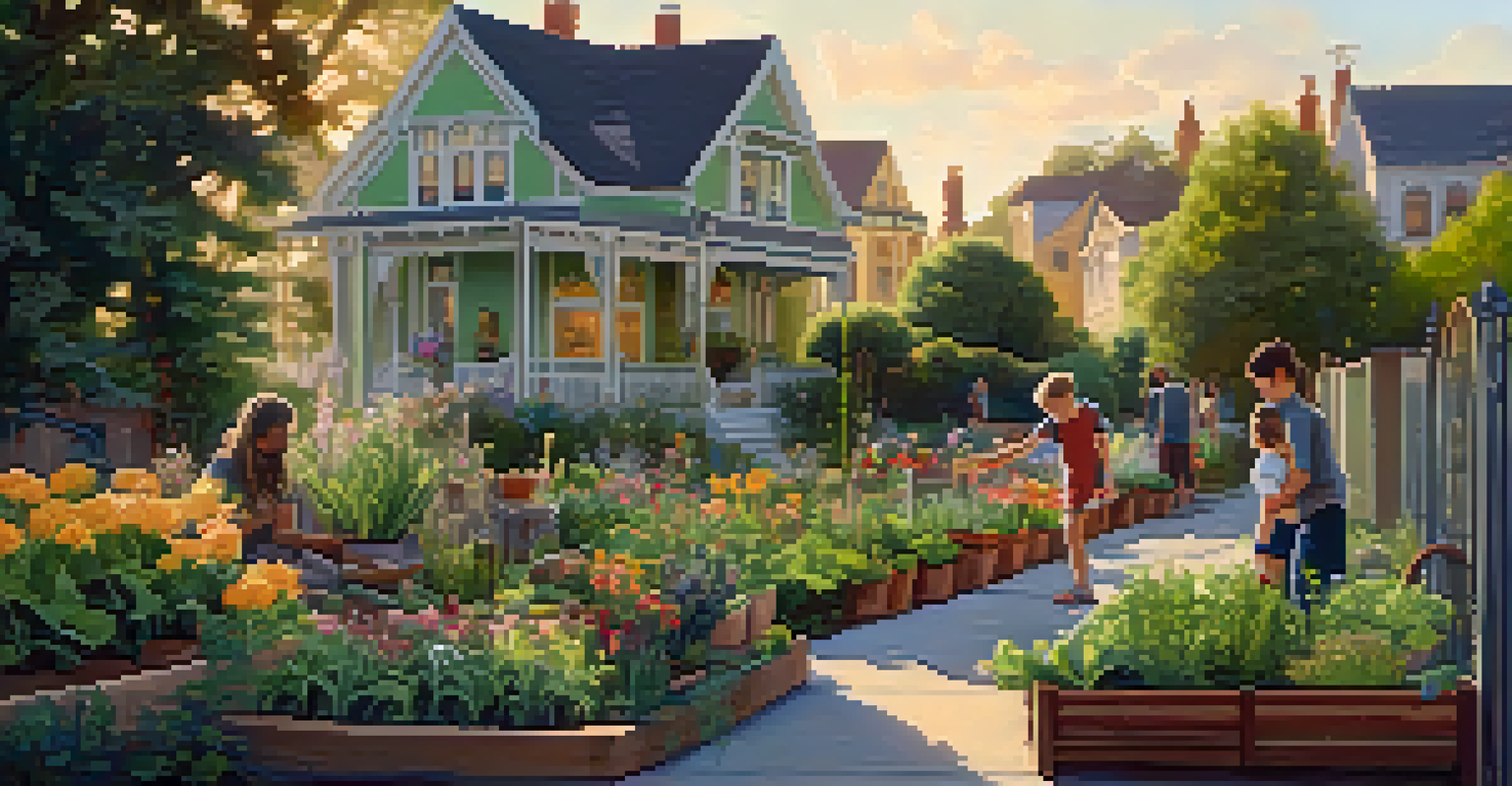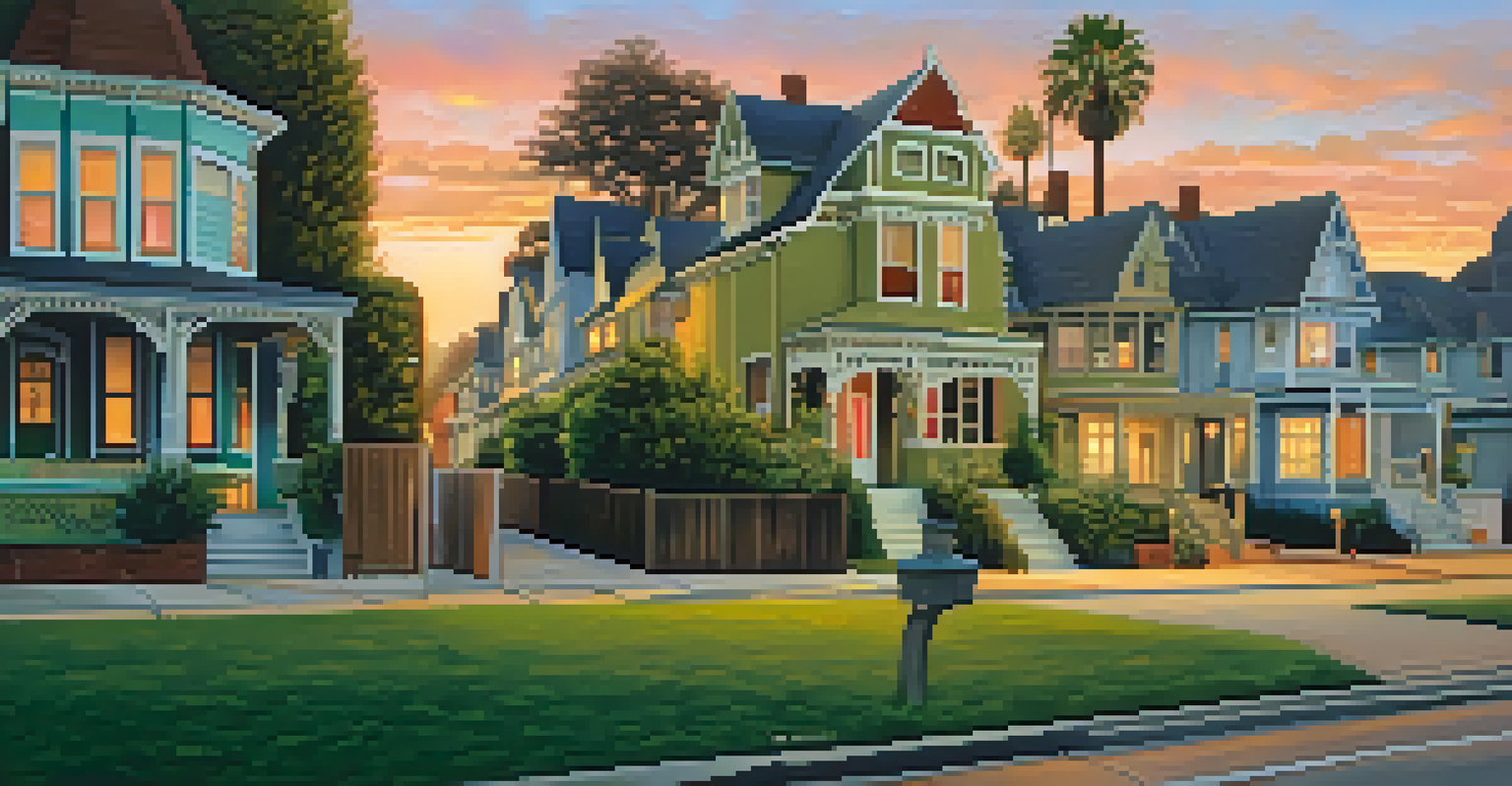The Evolution of California's Historic Neighborhoods Over Time

The Origins of California's Historic Neighborhoods
California's historic neighborhoods began forming in the 19th century, influenced by the state's rapid population growth during the Gold Rush. Towns and cities sprang up as hopeful prospectors sought their fortunes, leading to a diverse melting pot of cultures. Each neighborhood reflected the unique backgrounds of its residents, making them vibrant hubs of activity and innovation.
A city is not an accident but the result of coherent visions and aims.
For example, the Mission District in San Francisco was established by Spanish settlers, showcasing beautiful Mission-style architecture and a rich Latino culture. These early neighborhoods laid the groundwork for the diverse urban landscapes we see today, combining different architectural styles and community traditions.
As California continued to develop, these neighborhoods evolved, adapting to the changing needs of their residents while preserving elements of their historic charm. This blend of old and new is a key characteristic of California's neighborhoods, making them fascinating to explore.
The Impact of the Arts and Culture Movements
Throughout the 20th century, various arts and culture movements significantly influenced California's neighborhoods. Cities like Los Angeles and San Francisco became epicenters for artistic expression, attracting creatives from all over the world. The Beat Generation, for instance, found a home in neighborhoods like North Beach, infusing them with a sense of rebellion and innovation.

In addition to the literary scene, California also saw the rise of the counterculture movement in the 1960s, particularly in Haight-Ashbury. This neighborhood became synonymous with peace, love, and artistic freedom, leaving a lasting impact on its identity. The colorful murals, eclectic shops, and lively atmosphere continue to celebrate this rich history.
Historic Neighborhoods Evolve
California's historic neighborhoods have transformed over time, blending their rich past with modern influences and challenges.
These artistic movements not only shaped the cultural fabric of these neighborhoods but also transformed their physical landscapes, leading to a blend of historic architecture and modern creativity that defines California's neighborhoods today.
Urban Development and Gentrification Challenges
As California's economy boomed, urban development began to reshape historic neighborhoods, often leading to gentrification. This process, while revitalizing areas, frequently displaces long-time residents and erases the very culture that made these neighborhoods unique. Communities face the challenge of balancing growth with preservation, trying to maintain their historical character amid rising property values.
Preservation is a form of activism.
For instance, neighborhoods like Echo Park in Los Angeles have experienced significant changes as new businesses and residents move in. While this can lead to improved infrastructure and amenities, it often comes at the cost of displacing lower-income families and altering the neighborhood's original charm.
To combat these challenges, many communities are advocating for policies that promote affordable housing and support local businesses. This grassroots effort aims to ensure that the growth of these neighborhoods is inclusive, preserving their historic essence while embracing new opportunities.
Preservation Efforts and Community Activism
In response to the pressures of urban development, preservation efforts have gained momentum across California. Local organizations and activists are working tirelessly to safeguard historic landmarks and promote awareness about the importance of maintaining neighborhood identity. These groups often host community events, educational programs, and fundraising campaigns to rally support.
For example, the Los Angeles Conservancy has been instrumental in protecting architectural treasures from being demolished in the name of progress. Their advocacy work has led to the designation of several neighborhoods as historic districts, ensuring that their unique character is preserved for future generations.
Community Activism Drives Preservation
Local organizations and activists play a crucial role in safeguarding the unique character of neighborhoods against urban development pressures.
Community activism not only helps protect the past but also fosters a sense of pride and belonging among residents. By engaging with their local history, neighborhoods can create a shared narrative that strengthens community bonds and encourages civic participation.
The Role of Technology in Neighborhood Evolution
As we move further into the 21st century, technology plays a crucial role in the evolution of California's historic neighborhoods. From social media campaigns that promote local events to apps that connect residents with their community, technology has transformed how people engage with their surroundings. These tools make it easier for residents to communicate, collaborate, and advocate for their neighborhoods.
Additionally, technology facilitates the preservation of history through digital archives and virtual tours, allowing people to explore neighborhoods from the comfort of their homes. This not only increases awareness of historic sites but also draws interest from potential visitors and investors.
However, with these advancements come new challenges, such as ensuring equitable access to technology for all residents. Communities must navigate this digital landscape carefully to ensure that everyone can benefit from the opportunities that technology offers.
The Influence of Environmental Sustainability
In recent years, the push for environmental sustainability has begun to reshape California's historic neighborhoods. Residents and city planners are increasingly prioritizing green spaces, sustainable architecture, and eco-friendly practices. This shift not only enhances the quality of life for residents but also helps preserve the natural beauty of these neighborhoods.
For instance, urban gardens and community parks are cropping up in areas once dominated by concrete, providing residents with access to nature and fresh produce. These initiatives foster a sense of community while also addressing environmental concerns, such as urban heat islands and air quality.
Technology Shapes Neighborhood Interaction
The rise of technology enhances community engagement and historical preservation, offering new ways for residents to connect and advocate for their neighborhoods.
As these sustainable practices become more integrated into neighborhood planning, they offer a model for other cities grappling with similar issues. The blending of environmental consciousness with historic preservation creates a unique opportunity for neighborhoods to thrive in a changing world.
The Future of California's Historic Neighborhoods
Looking ahead, the future of California's historic neighborhoods appears dynamic and multifaceted. As new generations of residents move in, they bring fresh perspectives and ideas, invigorating these communities while retaining their historic charm. This ongoing evolution reflects the adaptability and resilience of neighborhoods that have withstood the test of time.
Moreover, collaboration between residents, local governments, and organizations will be crucial in shaping a sustainable and inclusive future. By working together, communities can address challenges like gentrification and environmental sustainability while honoring their unique histories.

Ultimately, California's historic neighborhoods will continue to serve as vibrant canvases where the past, present, and future intersect. Their ability to adapt and thrive in changing times will ensure that they remain cherished places for generations to come.